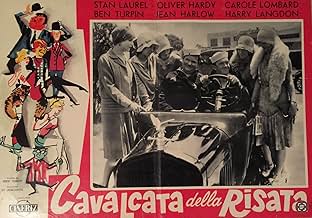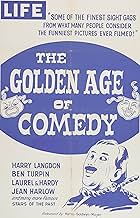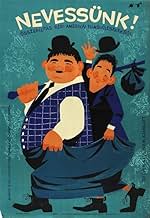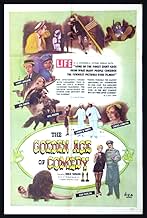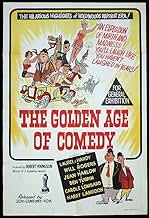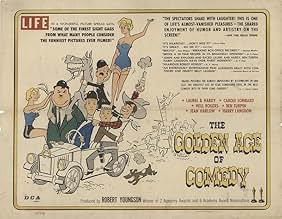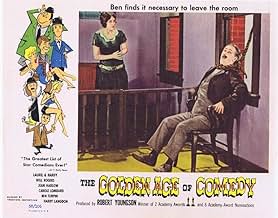अपनी भाषा में प्लॉट जोड़ेंA compilation of scenes featuring some of the best-known comics from the silent era in their best films.A compilation of scenes featuring some of the best-known comics from the silent era in their best films.A compilation of scenes featuring some of the best-known comics from the silent era in their best films.
Stan Laurel
- Stan
- (आर्काइव फ़ूटेज)
- (as Laurel)
Oliver Hardy
- Ollie
- (आर्काइव फ़ूटेज)
- (as Hardy)
Ben Turpin
- Rodney St. Clair
- (आर्काइव फ़ूटेज)
Andy Clyde
- Andy
- (आर्काइव फ़ूटेज)
Edgar Dearing
- Policeman at Car Fight
- (आर्काइव फ़ूटेज)
Madalynne Field
- Fat Girl Track Competitor
- (आर्काइव फ़ूटेज)
फ़ीचर्ड समीक्षाएं
Robert Youngson's first big compilation of silent comedy clips holds an important place in the history of film. Before this film, silent films were viewed as creaky antiques, suitable only for the occasional sneering jeer, like the "Goofy Movie" series and the rare fond memory of old-timers. It was only beginning in 1949, with Walter Kerr's article on the "Four Greats" of silent comedy, that a reappraisal began.
If, as some reviewers complain, there is no Lloyd, Keaton or Chaplin available here, well, their place was already being reestablished or, in Chaplin's case, had never been questioned. If the movie begins with a series of clips from the Sennett studios, it was surely Sennett's reputation which had sunk lowest, until he was recalled only as a purveyor of primitive pie fights in worn-out prints. Here, Youngson offers them in clean copies with admiring voice-overs and good musical accompaniment. If they're not the way the audience was intended to see them -- as complete films -- this surely shows them off to advantage as they had not been seen in thirty years. If nowadays the purist sneers at the film's perceived shortcomings, he should recognize that without Youngson's daring and surprisingly successful offering here, that purist would probably have never heard of those talents; given that almost all that survives of the Laurel & Hardy THE BATTLE OF THE CENTURY exists only because Youngson put most of its second reel here....
If, as some reviewers complain, there is no Lloyd, Keaton or Chaplin available here, well, their place was already being reestablished or, in Chaplin's case, had never been questioned. If the movie begins with a series of clips from the Sennett studios, it was surely Sennett's reputation which had sunk lowest, until he was recalled only as a purveyor of primitive pie fights in worn-out prints. Here, Youngson offers them in clean copies with admiring voice-overs and good musical accompaniment. If they're not the way the audience was intended to see them -- as complete films -- this surely shows them off to advantage as they had not been seen in thirty years. If nowadays the purist sneers at the film's perceived shortcomings, he should recognize that without Youngson's daring and surprisingly successful offering here, that purist would probably have never heard of those talents; given that almost all that survives of the Laurel & Hardy THE BATTLE OF THE CENTURY exists only because Youngson put most of its second reel here....
BY THE TIME that this first celluloid primer on the screen clowns of the Silent Screen hit the movie houses, the movies had been talking for about thirty years. It was 1957 and the USA was enjoying probably the most prosperous of times ever. We all had the marvels of Televisioon, right in our own living rooms.
SO WHY, YOU may ask, just why were we invited to our local neighborhood movie shows to view a 79 minute compilation of what was now considered obsolete, old hat, passé? All of us kids were familiar with "Old Time Movies" from their being screened on the various TV stations around the country. Names such as: Snub Pollard, Harry Langdon, Bobby Vernon and even the Mickey McGuire Series (starring a young Joe Yule, Jr.*) were all known to us.
BEING AN OBVIOUSLY Silent Film buff, Producer/Writer/Director Robert Youngson, set out to pay proper tribute and respect to both the Art Form and to those Men & Women who made it what it was. THE GOLDEN AGE OF COMEDY was his first installment.
THE CRAZY QUILT of a movie is made up of a multitude of clips taken from shorts featuring a array of actors' finest work. Getting high billing were names like: Will Rogers, Carole Lombard, Jean Harlow, Ben Turpin, Harry Langdon, Charley Chase, Billy Bevan and Andy Clyde. Stan Laurel & Oliver Hardy were given a Lion's share of the screen time; Mr. Youngson obviously being a buff.
WE REMEMBER SEEING the "coming attractions" at a Saturday Matinée, and the kids all enthusiastically cheered for Laurel & Hardy when they were mentioned. Once again, they were familiarized to us through the miracle of the Television Tube.
WE DID PAY our two bits to see it and very much enjoyed the samplings of clips from so many movies with so many unknown names. The narration was very informative, the music was both appropriate and acted as a very fine instrument for amplifying the visuals before us.
UPON FURTHER CONSIDERATION, all these decades later, we now have noticed something about THE GOLDEN AGE OF COMEDY that very well may not be readily observed before. Although what we saw was great in its own right, where were the big stars? THERE IS OBVIOUSLY omissions of what has been called the "Big Three" of the Silent Screen Clowns; those being: Charlie Chaplin, Bjuster Keaton and Harold Lloyd.
ALTHOUGH THIS WAS most likely done deliberately, we believe that there was no malice involved.
FIRST OF ALL, availability of films would be the prime moving force here. If they ain't out there, no one can get them. The accessible films must also have a price tag on their licensing that is within budget.(That makes two reasons).
THIRD WE BELIEVE that time constraints would not allow the proper attention to be given to the major Stars. A compilation such as this is, after all, an anthology; as well as being a sort of overview or survey, if you will.
LASTLY, THIS MID to late fifties was only a few, short years removed from that era of hearings by the House Committee on Un-American Activities and the staunch Anti-Communist sentiments of the day. It was in 1952 that the now very prosperous Mr. Charles Chaplin refused to fill out a declaration for American Officials; opting to stay in Europe, rather than returning to the U.S.
MOST OF THESE shortcomings were remedied in the very next Youngson production, WHEN COMEDY WAS KING; which prominently displayed works by Keaton and Chaplin. Harold Lloyd was still absent, tough. Owning the rights to most of his major films, he opted for a compilation of his own, HAROLD LLOYD'S WLORLD OF COMEDY (1962).
SO WHY, YOU may ask, just why were we invited to our local neighborhood movie shows to view a 79 minute compilation of what was now considered obsolete, old hat, passé? All of us kids were familiar with "Old Time Movies" from their being screened on the various TV stations around the country. Names such as: Snub Pollard, Harry Langdon, Bobby Vernon and even the Mickey McGuire Series (starring a young Joe Yule, Jr.*) were all known to us.
BEING AN OBVIOUSLY Silent Film buff, Producer/Writer/Director Robert Youngson, set out to pay proper tribute and respect to both the Art Form and to those Men & Women who made it what it was. THE GOLDEN AGE OF COMEDY was his first installment.
THE CRAZY QUILT of a movie is made up of a multitude of clips taken from shorts featuring a array of actors' finest work. Getting high billing were names like: Will Rogers, Carole Lombard, Jean Harlow, Ben Turpin, Harry Langdon, Charley Chase, Billy Bevan and Andy Clyde. Stan Laurel & Oliver Hardy were given a Lion's share of the screen time; Mr. Youngson obviously being a buff.
WE REMEMBER SEEING the "coming attractions" at a Saturday Matinée, and the kids all enthusiastically cheered for Laurel & Hardy when they were mentioned. Once again, they were familiarized to us through the miracle of the Television Tube.
WE DID PAY our two bits to see it and very much enjoyed the samplings of clips from so many movies with so many unknown names. The narration was very informative, the music was both appropriate and acted as a very fine instrument for amplifying the visuals before us.
UPON FURTHER CONSIDERATION, all these decades later, we now have noticed something about THE GOLDEN AGE OF COMEDY that very well may not be readily observed before. Although what we saw was great in its own right, where were the big stars? THERE IS OBVIOUSLY omissions of what has been called the "Big Three" of the Silent Screen Clowns; those being: Charlie Chaplin, Bjuster Keaton and Harold Lloyd.
ALTHOUGH THIS WAS most likely done deliberately, we believe that there was no malice involved.
FIRST OF ALL, availability of films would be the prime moving force here. If they ain't out there, no one can get them. The accessible films must also have a price tag on their licensing that is within budget.(That makes two reasons).
THIRD WE BELIEVE that time constraints would not allow the proper attention to be given to the major Stars. A compilation such as this is, after all, an anthology; as well as being a sort of overview or survey, if you will.
LASTLY, THIS MID to late fifties was only a few, short years removed from that era of hearings by the House Committee on Un-American Activities and the staunch Anti-Communist sentiments of the day. It was in 1952 that the now very prosperous Mr. Charles Chaplin refused to fill out a declaration for American Officials; opting to stay in Europe, rather than returning to the U.S.
MOST OF THESE shortcomings were remedied in the very next Youngson production, WHEN COMEDY WAS KING; which prominently displayed works by Keaton and Chaplin. Harold Lloyd was still absent, tough. Owning the rights to most of his major films, he opted for a compilation of his own, HAROLD LLOYD'S WLORLD OF COMEDY (1962).
10Petey-10
In 1957 Robert Youngson directed The Golden Age of Comedy which is a documentary with clips from the silent movies with our favorite comedians.You can see Stan Laurel and Oliver Hardy as jail birds who escape and they have to prove that they are painters.And in one clip Laurel and Hardy are having problems with cars and especially with the ones who are driving them.And who could forget the legendary pie throwing scene.The baby face Harry Langdon, offers lots of funny moments in the train.Billy Bevan and Mack Sennett's Cameo dog are hilarious.There are also clips from actors such as Will Rogers, Carole Lombard, Jean Harlow and the cross eyed Ben Turpin.For true silent comedy lovers it is impossible to get bored with The Golden Age of Comedy.Watch these golden clips from the silent era and have fun!
Personally, I wasn't all that keen on Chaplin, so his omission here doesn't bother me as it seems to others? Robert Youngson probably just never had the rights to use any of the material from those left out, although Keaton and Chaplin appeared in his next compilation. This is priceless entertainment, I think the music and added sound effects make these clips all the more enjoyable, plus the very witty and informative narration. Stan & Ollie are the standouts of course, for me the lengthy 'Two Tars' clips are the best, and the rest isn't far behind! Don't analyse it, just enjoy!
From the age of the Pie Fight comes this marvellous compilation by Robert Youngson.Watching it you can judge how much sheer joie - de vivre has been lost with the so - called "sophistication "of movie comedy in the ensuing decades.And where are the geniuses to rival Mr Chaplin and Mr Keaton?Who,today,is as universally loved as Mr Laurel and Mr Hardy whose masterwork "Big Business" is featured here? Feel free to laugh uproariously....."For Ghosts may be listening." "The Golden Age of Comedy" used to be a staple of Christmas Day TV. Sitting there watching it with a mince pie and a glass of port must be the nearest thing to paradise this side of the Elysian Fields.
क्या आपको पता है
- गूफ़The narrator cites a clip of Laurel and Hardy as coming from "We Slip Up." Laurel and Hardy never made a movie with that title. The actual movie referenced is We Faw Down (1928).
- इसके अलावा अन्य वर्जनThere is an Italian edition of this film on DVD, distributed by DNA Srl: "CAVALCATA DELLA RISATA (1957) + LA BOMBA COMICA (Ça c'est du cinéma, 1951)" (2 Films on a single DVD, with "Ça c'est du cinéma" in double version, with alternative cut titled "I terribili antenati di James Bond"), re-edited with the contribution of film historian Riccardo Cusin. This version is also available for streaming on some platforms.
- कनेक्शनEdited from The Dare-Devil (1923)
टॉप पसंद
रेटिंग देने के लिए साइन-इन करें और वैयक्तिकृत सुझावों के लिए वॉचलिस्ट करें
विवरण
- रिलीज़ की तारीख़
- कंट्री ऑफ़ ओरिजिन
- भाषा
- इस रूप में भी जाना जाता है
- The First Kings of Comedy
- IMDbPro पर और कंपनी क्रेडिट देखें
- चलने की अवधि1 घंटा 19 मिनट
- रंग
- ध्वनि मिश्रण
- पक्ष अनुपात
- 1.33 : 1
इस पेज में योगदान दें
किसी बदलाव का सुझाव दें या अनुपलब्ध कॉन्टेंट जोड़ें

